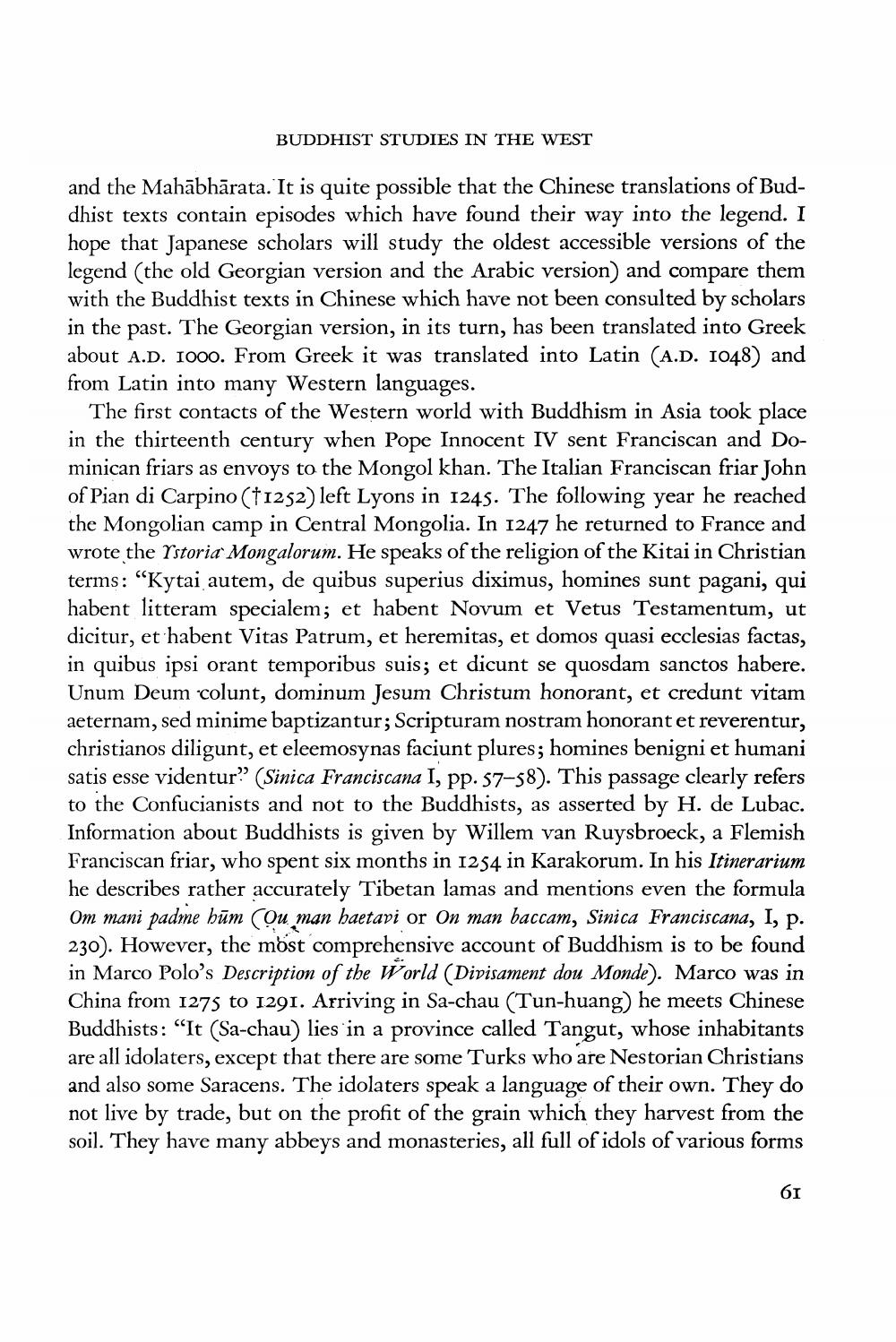Book Title: Brief History Of Buddhist Studies In Europe And Maerica Author(s): J W De Jong Publisher: J W De Jong View full book textPage 7
________________ BUDDHIST STUDIES IN THE WEST and the Mahābhārata. It is quite possible that the Chinese translations of Buddhist texts contain episodes which have found their way into the legend. I hope that Japanese scholars will study the oldest accessible versions of the legend (the old Georgian version and the Arabic version) and compare them with the Buddhist texts in Chinese which have not been consulted by scholars in the past. The Georgian version, in its turn, has been translated into Greek about A.D. 1000. From Greek it was translated into Latin (A.D. 1048) and from Latin into many Western languages. The first contacts of the Western world with Buddhism in Asia took place in the thirteenth century when Pope Innocent IV sent Franciscan and Dominican friars as envoys to the Mongol khan. The Italian Franciscan friar John of Pian di Carpino (†1252) left Lyons in 1245. The following year he reached the Mongolian camp in Central Mongolia. In 1247 he returned to France and wrote the Ystoria Mongalorum. He speaks of the religion of the Kitai in Christian terms: “Kytai autem, de quibus superius diximus, homines sunt pagani, qui habent litteram specialem; et habent Novum et Vetus Testamentum, ut dicitur, et habent Vitas Patrum, et heremitas, et domos quasi ecclesias factas, in quibus ipsi orant temporibus suis; et dicunt se quosdam sanctos habere. Unum Deum colunt, dominum Jesum Christum honorant, et credunt vitam aeternam, sed minime baptizantur; Scripturam nostram honorant et reverentur, christianos diligunt, et eleemosynas faciunt plures; homines benigni et humani satis esse videntur” (Sinica Franciscana I, pp. 57-58). This passage clearly refers to the Confucianists and not to the Buddhists, as asserted by H. de Lubac. Information about Buddhists is given by Willem van Ruysbroeck, a Flemish Franciscan friar, who spent six months in 1254 in Karakorum. In his Itinerarium he describes rather accurately Tibetan lamas and mentions even the formula Om mani padme hūm (ou man haetavi or On man baccam, Sinica Franciscana, I, p. 230). However, the most comprehensive account of Buddhism is to be found in Marco Polo's Description of the World (Divisament dou Monde). Marco was in China from 1275 to 1291. Arriving in Sa-chau (Tun-huang) he meets Chinese Buddhists: “It (Sa-chau) lies in a province called Tangut, whose inhabitants are all idolaters, except that there are some Turks who are Nestorian Christians and also some Saracens. The idolaters speak a language of their own. They do not live by trade, but on the profit of the grain which they harvest from the soil. They have many abbeys and monasteries, all full of idols of various forms 61Page Navigation
1 ... 5 6 7 8 9 10 11 12 13 14 15 16 17 18 19 20 21 22 23 24 25 26 27 28 29 30 31 32 33 34 35 36 37 38 39 40 41 42 43 44 45 46 47 48 49 50 51 52 53 54 55 56 57 58 59 60 61 62 63 64 65 66 67 68 69 70 71 72 ... 86
